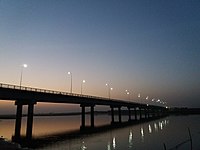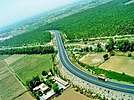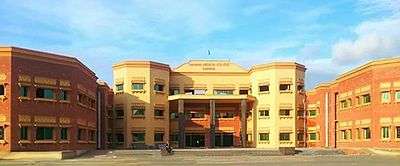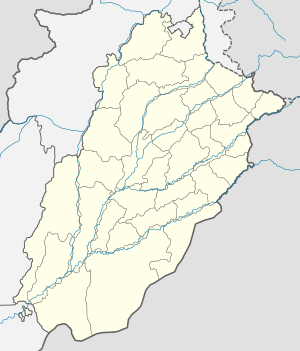Sahiwal
Sahiwal (Punjabi and Urdu: ساہِيوال) is a city in Punjab, Pakistan. It is the administrative center of Sahiwal District and Sahiwal Division. It is the 21st largest city of Pakistan by population.[2] Sahiwal is approximately 180 km from the major city Lahore and 100 km from Faisalabad and lies between Lahore and Multan.
Sahiwal ساہِيوال | |
|---|---|
City | |
    From top to bottom: Sahiwal Railway Station, Ravi Bridge, Chichawatni Forest, Sahiwal Medical College | |
 Sahiwal  Sahiwal | |
| Coordinates: 30°39′40″N 73°6′30″E | |
| Country | |
| Province | |
| District | Sahiwal |
| Government | |
| • Type | Metropolitan Corporation |
| Area | |
| • City | 60 km2 (20 sq mi) |
| • Metro | 3,201 km2 (1,236 sq mi) |
| Elevation | 152.4 m (500.0 ft) |
| Population | |
| • City | 389,605 |
| • Rank | 21st, Pakistan |
| • Density | 6,500/km2 (17,000/sq mi) |
| Time zone | UTC+5 (PST) |
| Calling code | 040 |
| No. of Union Councils | 52 (11 urban, 41 rural)[1] |

A small village on the Karachi-Lahore railway line during 1865 was named Montgomery after Sir Robert Montgomery, then Lieutenant-Governor of Punjab.[3][4] Later, it was made the capital of the Montgomery District. Its name was reinstated as Sahiwal in 1966.
The city is in the densely populated region between the Sutlej and Ravi rivers. The principal crops are wheat, cotton, tobacco,[5] legumes, potato[6] and oil seeds. Cotton goods and lacquered woodwork are manufactured.[3][7]
History
The Sahiwal District has been settled from the pre-historical era. Harappa is an archaeological site, about 35 km (22 mi) west of Sahiwal, that was built approximately 2600 BCE. The area was part of Indian empires and in crossroads of migrations and invasions from Central Asia. The pastoral tribes of this barren expanse did not appear to have paid more than a nominal allegiance to the Muslim rulers, the population for the most part remained in a chronic state of rebellion. Sahiwal is located close to Pakpattan, a famous medieval town and Muslim Sufi pilgrimage site. Pakpattan owes its sanctity and modern name, 'the holy ferry', to the shrine of the great Muslim Sufi Fariduddin Ganjshakar Shaikh-ul-Islam, Farid-ul-Hakkwa-ud-Din, Shakar Ganj (1173–1265) which was visited by old great traveler and historian Ibn Batuta in 1334. The native population converted to Islam by Sufi missionaries. After the decline of the Mughal Empire, the Sikh took control of Sahiwal. The inhabitants were treated benevolently during Sikh rule. The district came under direct British rule in 1849, when the district was officially formed with its headquarters at Pakpattan. The district was expanded to include the trans-Ravi portion in 1852, and the district headquarters were moved to Gogera. In 1865, when the railway was opened, a village on the railway side, was named "Montgomery" and became the capital of the district.[8]
During the Indian Rebellion of 1857, there was a general uprising of the Muslim population of Sahiwal, and the district formed the scene of the only uprising which took place north of Sutlej. Before the end of May 1857, emissaries from Delhi crossed the river from Sirsa and Hisar, where open rebellion was already ripe, and met with a ready reception from the Kharals and various other Muslim tribes. The district authorities, however, kept down the threatened uprising till August 26, 1857 when the prisoners in jail made a desperate attempt to break loose. At the same time Ahmad Khan, a famous Kharal leader, who had been detained at Gogera, broke his arrest, and though apprehended, was released on security, together with several other suspected chieftains. On September 16, they fled to their homes, and the whole country rose in open rebellion. Kot Kamalia was sacked; and Major Chamberlain, moving up with a small force from Multan, was besieged for some days at Chichawatni on the Ravi. The situation at the civil station remained critical till Colonel Paton arrived with substantial reinforcements from Lahore. An attack which took place immediately after their arrival was repulsed. Several minor actions followed in the open field, until finally the rebels, driven from the plain into the jungles of the interior, were utterly defeated and dispersed. The British troops then inflicted severe punishment on the insurgent clans, destroying their villages, and seizing large numbers of herds.[9]
The district council authorised that the name be changed from Montgomery to Sahiwal in 1966. Sahiwal has an important new railway station.
Climate
The climate of Sahiwal district is extreme, reaching 34 °C in summer, and down to 4 °C in winter. The soil of the district is very fertile. The average rainfall is about 2000 mm.[10]
Education
Following are some of notable educational institutes of the city:
- University of Sahiwal[11]
- COMSATS University, Sahiwal Campus
- Sahiwal Medical College[12]
- Quaid-e-Azam College of Engineering and Technology, Sahiwal
- Punjab College of Science
- The Superior College
- Army Public Schools & Colleges System (APSCS)
- Beaconhouse School System
- Bloomfield Hall School
- The City School
- Divisional Public School and College
- The Educators
Twin city
Sahiwal is twinned with the town of Rochdale, in Greater Manchester, North West England. Approximately eight per cent of town's population is of Asian origin, most of whom have links with Pakistan. The twinning arrangement was agreed between Rochdale and Sahiwal in 1998.[13][14]
Notable people from Sahiwal
- Majeed Amjad, Urdu poet
- Mushtaq Ahmed, former test cricketer
- Manzoor Elahi, former test cricketer
- Tariq Aziz, television anchor
- Attash Durrani, Urdu writer and Scholar
- Rana Mohammad Hanif Khan, politician and former Finance Minister of Pakistan
- Kunwar Mohinder Singh Bedi Sahar, Urdu Poet
- Nouraiz Shakoor, politician and former Federal minister
- Sain Zahoor, Sufi musician
- Nazir Naji journalist and Urdu columnist for the Daily Dunya
- Emmanuel Neno, Christian author and translator
- Dildar Pervaiz Bhatti, (TV artist, compere, comedian, anchor)
- Brigadier Kuldip Singh Chandpuri, MVC, VSM, Indian Army Officer
References
- "Table 209". Punjab Development Statistics 2016 (PDF). Bureau of Statistics, Government of The Punjab. p. 335(340). Retrieved 28 May 2017.
- "Pakistan City & Town Population List". Tageo.com website. Retrieved 29 September 2017.
- The New Encyclopædia Britannica: Micropædia. Encyclopædia Britannica. 1991. ISBN 978-0-85229-529-8. Retrieved 18 July 2011.
- A history by Sahiwal Police Archived 2009-05-23 at the Wayback Machine
- Agricultural Research Council (Pakistan) (1 January 1980). Pakistan journal of agricultural research. Pakistan Agricultural Research Council. Retrieved 18 July 2011.
- Nazli, Caesar B. Cororaton, Abdul Salam, Zafar Altaf, David Orden and Reno Dewina, Nicholas Minot, Hina. Cotton-Textile-Apparel Sectors of Pakistan: Situations and Challenges Faced. Intl Food Policy Res Inst. p. 47. GGKEY:1W7L1FH7N4N. Retrieved 18 July 2011.
- Cotton handbook of Pakistan. Pakistan Central Cotton Committee. 1983. p. 217. Retrieved 18 July 2011.
- "Montgomery District, Imperial Gazetteer of India, v. 17, p. 410., 1860–1922". Dsal.uchicago.edu. Retrieved 2013-02-18.
- "Montgomery District – Imperial Gazetteer of India, v. 17, p. 411". Dsal.uchicago.edu. Retrieved 2013-02-18.
- ":Govt. Post Graduate College Sahiwal:". Gpgcs.edu.pk. Retrieved 2017-11-08.
- https://uosahiwal.edu.pk
- http://www.slmc.edu.pk
- "Punjab Assembly". Pap.gov.pk. Retrieved 2010-03-24.
- "Town twinning". rochdale.gov.uk. Archived from the original on 29 October 2007. Retrieved 8 August 2016.
